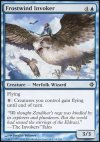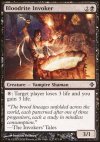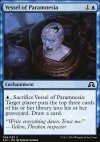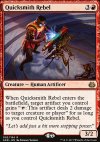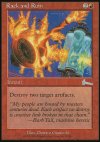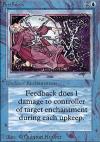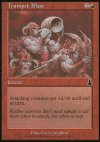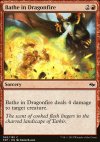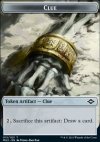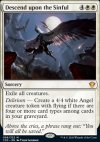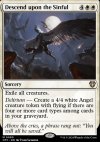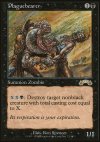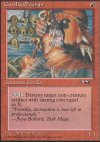|

MV anecdotes
| 4843 anecdotes trouvées |   |
Zhulodok, Void Gorger est une engeance d'Ulamog, the Ceaseless Hunger pour être son avatar ; il est le responsable de la création des vampires sur le Plan de Zendikar.
Parmi les Cultistes adorateurs de la divinité qui s'est avérée être un des titans Eldrazis (voir cette anecdote et celle-ci) et qui ont permis sa propre libération, il en a épargné douze, et les a transformés en vampires serviteurs des Eldrazis, comme le montre l'illustration de Bloodchief Ascension : Drana, Kalastria Bloodchief, Liberator of Malakir, et the Last Bloodchief, et les autres chefs de sang étant ainsi à l'origine des douze lignées de vampires de Zendikar.
Cette création est d'ailleurs à la source du conflit entre Nahiri, the Lithomancer et Sorin Markov (voir cette anecdote, celle-ci et celle-là), celle-ci ne sachant pas que ce sont les Eldrazis qui en sont les réels instigateurs.
Source (vidéo d'Aether Hub - #MTGAmbassador)
Parmi les Cultistes adorateurs de la divinité qui s'est avérée être un des titans Eldrazis (voir cette anecdote et celle-ci) et qui ont permis sa propre libération, il en a épargné douze, et les a transformés en vampires serviteurs des Eldrazis, comme le montre l'illustration de Bloodchief Ascension : Drana, Kalastria Bloodchief, Liberator of Malakir, et the Last Bloodchief, et les autres chefs de sang étant ainsi à l'origine des douze lignées de vampires de Zendikar.
Cette création est d'ailleurs à la source du conflit entre Nahiri, the Lithomancer et Sorin Markov (voir cette anecdote, celle-ci et celle-là), celle-ci ne sachant pas que ce sont les Eldrazis qui en sont les réels instigateurs.
Source (vidéo d'Aether Hub - #MTGAmbassador)
Les cinq cartes Dawnglare Invoker, Frostwind Invoker, Bloodrite Invoker, Lavafume Invoker et Wildheart Invoker, de l'édition Rise of the Eldrazi, forment un cycle appelé "Invoker". De plus leurs textes d'ambiance se succèdent pour constituer un texte annonçant l'éveil des Eldrazis sur Zendikar.
Les cartes Valakut Invoker, Oran-Rief Invoker et Razorgrass Invoker parues ensuite font référence à ce cycle.
Ce cycle est inspiré d'un autre cycle paru dans l'édition Legions (voir cette anecdote).
Les cartes Valakut Invoker, Oran-Rief Invoker et Razorgrass Invoker parues ensuite font référence à ce cycle.
Ce cycle est inspiré d'un autre cycle paru dans l'édition Legions (voir cette anecdote).
Les cinq cartes Vessel of Ephemera, Vessel of Paramnesia, Vessel of Malignity, Vessel of Volatility et Vessel of Nascency, de l'édition Shadows over Innistrad et illustrées par Kieran Yanner, forment un cycle appelé "Vessel".
Les deux cartes Quicksmith Spy et Quicksmith Rebel, de l'édition Aether Revolt, forment une paire. De plus leurs textes d'ambiance se font écho.
Les deux cartes Balshan Collaborator et Pardic Collaborator, de l'édition Torment, forment une paire.
Les deux cartes Wall of Bone et Wall of Brambles, de l'édition Limited (Alpha) et illustrées par Anson Maddocks, forment une paire.
Sur l'illustration de la carte Jihad, on peut voir les mêmes soldats que sur Army of Allah.
Ces deux cartes sont illustrées par Brian Snoddy.
Ces deux cartes sont illustrées par Brian Snoddy.
Sur l'illustration de la carte Ravenous Gigamole, on peut voir une gigataupe dévorer un Yotian Frontliner.
Sur l'illustration de la carte Bathe in Dragonfire, c'est Atarka, World Render qui crache du feu.
Sur l'illustration de la carte Hard Evidence, on peut distinguer exactement les mêmes jetons Crab et Clue créés, auxquels il est également fait allusion dans le texte d'ambiance.
Toutes ces cartes sont illustrées par Yeong Hao Han.
Toutes ces cartes sont illustrées par Yeong Hao Han.
Le texte d'ambiance de la carte Nested Shambler fait référence à une expression anglaise, "Home is where the heart is", "le foyer, c'est là où se trouve le cœur", qui signifie qu'on est vraiment chez soi là où l'on se sent bien - le "cœur" étant ici utilisé de façon figurée.
Avec le Nested Shambler, il y a un jeu de mots, l'expression est mise au passé et le "cœur" est cette fois pris au sens propre : les écureuils ont réellement fait leur nid là où se trouvait autrefois physiquement le cœur du zombie, et ont donc élu domicile dans sa cage thoracique. Ce texte d'ambiance est bien sûr très difficilement traduisible en français.
Avec le Nested Shambler, il y a un jeu de mots, l'expression est mise au passé et le "cœur" est cette fois pris au sens propre : les écureuils ont réellement fait leur nid là où se trouvait autrefois physiquement le cœur du zombie, et ont donc élu domicile dans sa cage thoracique. Ce texte d'ambiance est bien sûr très difficilement traduisible en français.
Le texte d'ambiance de la carte Shadow of Doubt fait référence à l'expression anglaise "Ignorance Is Bliss", qui peut se traduire en français par l'expression "Bienheureux sont les pauvres d'esprit" mais qui n'a cependant pas la même origine.
Le texte d'ambiance en français ne rend pas cette expression directement : "Vous êtes peut-être innocent, mais ce sont mes mains qui sont pleines."
Le texte d'ambiance en français ne rend pas cette expression directement : "Vous êtes peut-être innocent, mais ce sont mes mains qui sont pleines."
La traduction française du nom de la carte Sleep with the Fishes n'est pas littérale et par conséquent déforme quelque peu le propos initial.
"Sleep with the fishes" se traduit littéralement par "dormir avec les poissons" qui signifie "être assassiné" (plus aligné avec l'illustration également), là où "boire le bouillon" signifie plutôt "subir un échec, un malheur".
"Sleep with the fishes" se traduit littéralement par "dormir avec les poissons" qui signifie "être assassiné" (plus aligné avec l'illustration également), là où "boire le bouillon" signifie plutôt "subir un échec, un malheur".
La carte Descend upon the Sinful, de l'édition Shadows over Innistrad, présente une erreur de traduction dans sa version française : son nom est traduit par "Fondre sur les pêcheurs" au lieu de "Fondre sur les pécheurs", "pêcheurs" avec cette orthographe ne correspondant pas à "the Sinful" mais à "fishermen".
La traduction a été corrigée avec sa réimpression dans l'édition Commander 2020.
La traduction a été corrigée avec sa réimpression dans l'édition Commander 2020.
La dernière capacité de la carte Karn, Living Legacy, de l'édition Dominaria United, permet de créer un emblème. Or, il n'existe aucun jeton pour cet emblème, contrairement aux autres emblèmes créés par les planeswalkers présents dans cette même édition.
Search ~ jeton + Nom contient Emblem dans Dominaria United - Source 1 ("I believe it was an accident and not purposefully done.") - Source 2 - Source 3 ("Karn is missing his token") - Source 4 ("Karn's missing his token")
Search ~ jeton + Nom contient Emblem dans Dominaria United - Source 1 ("I believe it was an accident and not purposefully done.") - Source 2 - Source 3 ("Karn is missing his token") - Source 4 ("Karn's missing his token")
La carte Plaguebearer est une référence à Gorilla Shaman de par ses force et endurance et son effet, transposé d'un artefact à une créature.
Les cartes de l'édition Exodus ont, dans leur version allemande, un symbole d'édition plus petit que pour toutes les autres langues. La raison est qu'avec l'Allemand, les types et sous-types de cartes prennent plus de place à écrire et la taille du symbole original aurait posé problème.
Exemple avec la carte Furnace Brood dont les type et sous-type (types de carte et de créature) s'écrivent "Beschwörung von Elementarwesen".
Exemple avec la carte Furnace Brood dont les type et sous-type (types de carte et de créature) s'écrivent "Beschwörung von Elementarwesen".
| 4843 anecdotes trouvées |   |






 Avatar: the Last Airbender
Avatar: the Last Airbender Spider-Man / Omenpaths
Spider-Man / Omenpaths Edge of Eternities
Edge of Eternities Final Fantasy
Final Fantasy Tarkir: Dragonstorm
Tarkir: Dragonstorm Aetherdrift
Aetherdrift Foundations
Foundations



